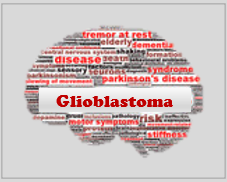
Glioblastoma
Is a grade IV malignant brain tumour that develops from glial cells in the brain. Glial cells are cells that support and nourish neurons.
Glioblastoma is characterised by rapid and uncontrolled cell proliferation, leading to the formation of an aggressive and invasive tumour mass in the brain.
Glioblastoma can be divided into two different molecular subtypes: primary glioblastoma and secondary glioblastoma. Primary glioblastoma develops rapidly from normal brain cells, whereas secondary glioblastoma develops from a pre-existing brain tumour, such as a grade II or III astrocytoma.
The exact cause of glioblastoma is unknown, but certain risk factors have been identified, including exposure to ionising radiation, a genetic predisposition and a weakened immune system.
In summary, glioblastoma is an aggressive malignant brain tumour that develops from the glial cells of the brain.
There are several biomarkers that have been identified for glioblastoma, which can help diagnose the disease, guide treatment options and predict response to treatment. Here are some examples of glioblastoma biomarkers:
1. The IDH1 mutation: this mutation is present in approximately 10% of glioblastomas and is associated with a better prognosis and improved response to chemotherapy.
2. The IDH2 mutation: this mutation is also present in a small proportion of glioblastomas and is associated with a more favourable prognosis than tumours that do not have the mutation.
3. DNA methylation: analysis of DNA methylation can help distinguish glioblastoma from other types of brain tumour and can also predict response to treatment.
4. Overexpression of EGFR (epidermal growth factor receptor): this is present in around half of glioblastomas and is associated with a poorer prognosis and a less favourable response to radiotherapy.
5. Presence of MGMT protein: MGMT protein expression can help predict response to alkylating chemotherapy and guide treatment decisions.

